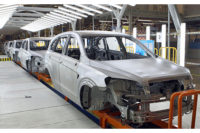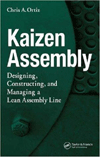A fastener handling system solved the problem. The fastener handling system uses an escape-and-blow mechanism to deliver the fasteners to a receiver head, eliminating the most time-consuming part of the previous operation. The handling system also eliminated the costly problem of fasteners dropping on the floor. The system’s design includes a modular supply hopper, vibratory bowl feeder and an integrated electric-drive power screwdriver.
Rivnut fasteners are internally threaded fasteners produced by Bollhoff Rivnut Inc. (Kendallville, IN) that can be installed in seconds by a single operator from one side of the work. When in place, they form secure nut plates with clean threads for screw attachments. The fasteners stay firmly anchored, even when repeatedly assembled. They are available in more than 5,000 sizes and styles. The style used on General Motor’s sport utility vehicles features thin-wall shanks that compress during installation, forming large flanges. These flanges spread loads evenly over a large area. This provides outstanding pull-out resistance. Other benefits include wide grip range, and exceptional torque and thread strength.
These fasteners are commonly used in the automotive industry for attaching carrier racks and other external components to automobile and truck bodies. They provide a durable and inexpensive method of attaching hardware. They can be bolted securely to a sheet metal body without requiring access to the other side.
To attach the carrier racks, an operator normally carries a bag of the fasteners along the moving assembly line. The operator pulls a fastener from the bag, positions it into a hex hole and grabs an electric screwdriver. The operator does this while holding a fastener. The operator then tightens the fastener.
In a typical application, operators on each side of the vehicle are barely able to attach the fasteners within the allotted 50 seconds of cycle time using traditional manual methods. Adding a second operator on each side of the line would substantially increase costs. While performing this operation, many fasteners are dropped on the floor. Later on, these fasteners are swept up and thrown away. Another problem is that the loose fasteners on the floor are a potential safety hazard.
For these reasons, Classic Design (Troy, MI), a systems integrator, was contacted to develop an automated process for installing the fasteners. Classic Design selected MCI Screwdriver Systems Inc. (Noblesville, IN) to develop the fastener handling system. According to Dale Markgraf, project manager, "We selected MCI because of their reputation as a problem solver. To the best of my knowledge, this type of operation had never been automated before, so a considerable amount of creative thinking would definitely be required."
MCI engineers studied the existing process by using existing tools sent by General Motors. After studying the existing process, MCI developed a system whereby a modular bulk supply hopper feeds parts to a polycast vibratory bowl mechanism. With a vibratory bowl feeder, parts are dumped into a bowl. The parts then vibrate uphill along a track toward an outlet, where rejected parts fall off the track and are recycled. Motion is channeled so that each part automatically assumes a specified orientation.
In this case, the part should be hanging by the flange. From the vibratory bowl, the fasteners are tracked to an escape-and-blow mechanism.
The fasteners are blown through a flex tube with the flanged end trailing to a handheld screwdriver. Computer numerical control-machined receiver head tooling was modified to perform this task, providing further reductions in design and manufacturing costs.
With the fastener held in the receiving head, the operator positions the fastener in the hex hole of the truck body. The operator then pushes the lever of the driver. The driver pushes the head of the fastener past the jaws of the receiver head. The driver stud threads into the fastener, beginning the torquing process. The fastener compresses in the thin wall area. The driver stud bottoms out, and the driver reverses automatically. Another fastener is then blown into the receiver head, and the cycle is repeated.
MCI modified its standard electrical process to accommodate this unusual sequence and worked with General Motors to develop an externally mounted set of controls that complied with specifications.
When the project was near completion, General Motors, Classic Design and MCI finalized the development of the system. They decided an electric motor, rather than a pneumatic system, would reduce cycle time and require less maintenance. Reduced maintenance and part replacement compensated for the additional cost of the electric motors and monitoring controls.
"The new fastener handling system reduced the cycle time for installation of five fasteners to about two-thirds of the time previously required to install four," Markgraf says. "Fasteners are now fed directly from the supply hopper to the holes, eliminating the possibility of Rivnuts falling on the floor. Rather than having to add extra operators, General Motors has simplified the job so that a single person can perform it. Finally, the high quality that was provided by the old process has been maintained in the new one."
For more information on fastener handling systems, call MCI Screwdriver Systems Inc. at 317-776-1970, www.mci-screwdrivers.com.
For more information on systems integration, call Classic Design Inc. at 248-588-2738.
For more information on internally threaded fasteners, call Bollhoff Rivnut Inc. at 877-347-3903 or visit www.bollhoff-rivnut.com.




